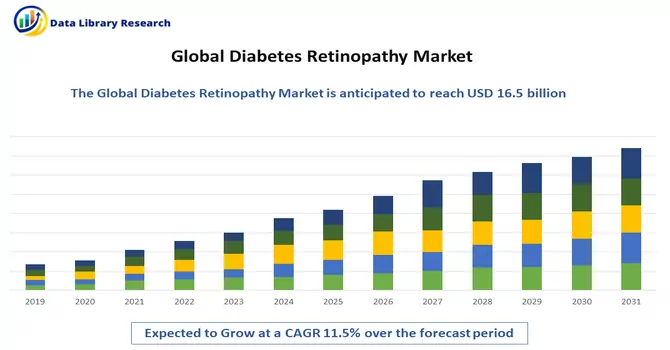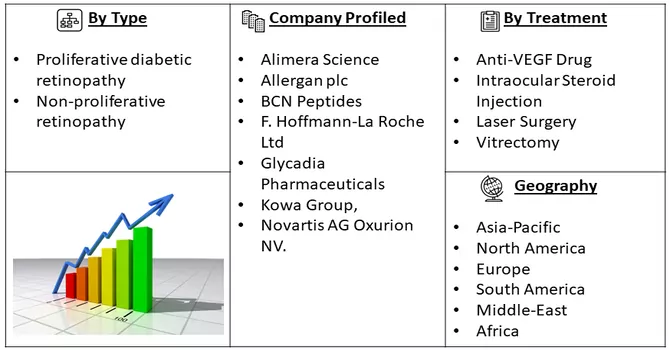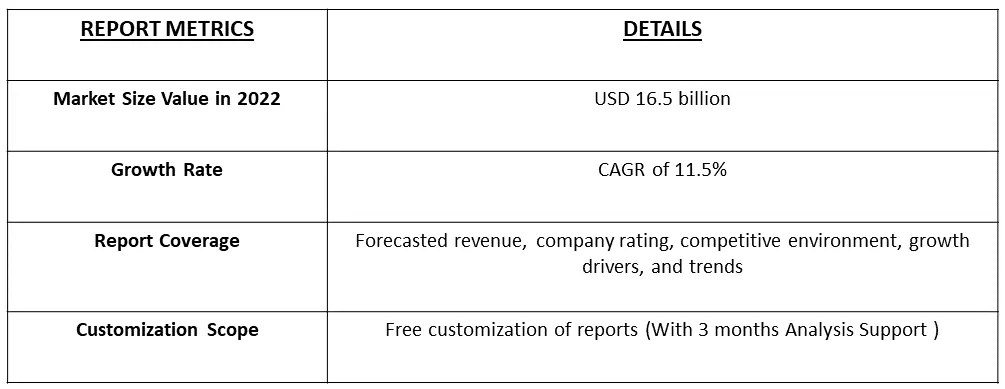The Diabetes Retinopathy Market is currently valued at USD 16.5 billion in the year 2022 and is expected to register a CAGR of 11.5% over the forecast period, 2023-2030.

Get Complete Analysis Of The Report - Download Free Sample PDF
Diabetic retinopathy refers to a diabetes complication that affects the eyes, DR results in damage to the blood vessels of the light-sensitive tissue at the back of the eye (retina). Initially, diabetic retinopathy may cause no symptoms or only mild vision problems. But eventually, it can cause blindness.
The factors that are driving the market growth include the rising prevalence of diabetes and blindness due to the same, the growing geriatric population base, and increasing technological advancements in diabetic retinopathy surgical instruments.
Latest Trends:
Some of the latest scientific studies in the field of Diabetes retinopathy Market is expected to bring some of the latest developments. For instance, NovaGo Therapeutics is developing a first-in-class fully human antibody therapy to treat diabetic retinopathy. With its novel disease-modifying mode of action, it could save the sight of the many patients who respond poorly to current treatments.
Segmentation:
The Report Covers the Diabetic Retinopathy Market Forecast and it is segmented
By Type
By Treatment
Geography
The Values are Provided in Terms of USD Million for the above segments.

For Detailed Market Segmentation - Download Free Sample PDF
Drivers:
Increasing Diabetes Cases
Diabetic retinopathy (DR) is a leading cause of vision loss globally. The most clinically important risk factors for progression to vision loss include the duration of diabetes, hyperglycemia, and hypertension. Control of serum glucose and blood pressure is effective in preventing vision loss due to DR. There is an increasing burden of diabetic retinopathy across the globe. The increasing burden of diabetes is also driving the growth of the market. As per "Diabetic Retinopathy Screening: A Short Guide" published by the World Health Organization in 2020, the prevalence of any retinopathy in persons with diabetes is 35% while proliferative (vision-threatening) retinopathy is 7%. Additionally, the International Diabetes Federation Diabetes Atlas, 10th edition 2021 reported that in 2021, globally there are about 536,600,000 people with diabetes, and it is estimated to reach 783,700,000 by the year 2045. such a growing burden of diabetes increases the risk of diabetes retinopathy and thus, is expected to drive the growth of the market.
Technological Development
Additionally, the services launched for the diagnosis and improvement in diagnosis are also driving the growth of the market in the country. For Instance, in December 2021, Eyenuk, Inc in collaboration with Discovery Health launched a new Diabetic Retinopathy Screening Benefit nationwide in South Africa, powered by the cutting-edge EyeArt Artificial Intelligent System. It helps in enabling the detection of the onset of diabetic retinopathy as early as possible. Such benefits plans and services increase the early detection of diseases and hence drive the growth of the market.
Restraints:
Lack of Skilled Ophthalmologists and Extended Time for Product Approvals
There is a lack of ophthalmologists, even more in developing countries. Therefore, developing new screening possibilities, which could be used without an available ophthalmologist, is favorable. Thus, the lack of ophthalmologist may slow down the growth of the studied market.
The COVID-19 pandemic led to disruption in not only the research and development activities of other therapies and drugs for medical conditions other than COVID-19 but also impacted the treatment procedures and supply chain of the pharmaceuticals and medical devices around the world which also impacted the studied market of diabetic retinopathy. However, lockdown led to the sudden transition to online activities which not only involved work but also education and entertainment and this led to an increase in the screen time of individuals along with the usage of vision correction devices such as contact lenses and spectacles. Further, the COVID-19 pandemic is expected to have a long-term impact on people as today a significant number of daily activities are being performed online which may hurt the eyes and lead to an increase in the demand for vision correction drugs and devices, thus positively impacting the market.
Segmental Analysis:
The proliferative diabetic retinopathy segment currently dominates the global diabetic retinopathy market and is expected to continue during the forecast period owing to the increasing prevalence of the medical condition worldwide. Globally, in 2017, among adults aged 45 and over with diagnosed diabetes, 32.2% had cataracts, 8.6% had diabetic retinopathy, 7.1% had glaucoma, and 4.3% had macular degeneration. This can serve as a major opportunity for manufacturers to capitalize on and expand their market share.
North America Dominates the Market and Expected to Do Same in the Forecast Period
North America is expected to be significantly driven during the study period owing to factors such as the rising prevalence of diabetes and blindness, the growing geriatric population, and increasing technological advancements in diabetic retinopathy surgical instruments. Over the past decade, the prevalence of diabetes in North America has increased. People with diabetes are at risk for diabetic retinopathy. Diabetic retinopathy is the leading cause of new cases of blindness among adults aged 20 to 74 years in the United States. According to the data published by the Centers for Disease Control and Prevention (CDC) in 2020 around 4.1 million Americans are affected with diabetic retinopathy, and nearly 900,000 Americans are threatened with vision-damaging retinopathy. Hence the increasing number of people living with diabetic retinopathy is expected to contribute to market growth across the country.

Get Complete Analysis Of The Report - Download Free Sample PDF
Competitive Landscape:
The Diabetic Retinopathy market is moderately competitive and consists of a few major players. The players are adopting strategies such as partnerships and acquisitions, product launches, research and development activities, and rising investments to strengthen their presence in the market. Below listed companies are working in this domain:
Recent Developments:
1) In June 2022, Regeneron Pharmaceuticals, Inc. announced that the United States Food and Drug Administration (FDA) accepted for review the EYLEA (aflibercept) Injection supplemental Biologics License Application (sBLA) for every 16-week 2 mg dosing regimen (after initial monthly doses) in patients with diabetic retinopathy (DR).
2) In February 2022, REGENXBIO Inc. announced additional positive interim data from the ongoing Phase II ALTITUDE trial of RGX-314 for the treatment of diabetic retinopathy (DR) without center-involved diabetic macular edema (CI-DME) using in-office suprachoroidal delivery.
Q1. What is the current Diabetes Retinopathy Market size??
The Diabetes Retinopathy Market is currently valued at USD 16.5 billion.
Q2. What is the Growth Rate of the Diabetes Retinopathy Market?
Diabetes Retinopathy Market is expected to register a CAGR of 11.5% over the forecast period.
Q3. What segments are covered in the Diabetes Retinopathy Market Report?
By Type, By Management Approach & Geography these segments are covered in the Diabetes Retinopathy Market Report.
Q4. Which region has the largest share of the Diabetes Retinopathy Market? What are the largest region's market size and growth rate??
North America has the largest share of the market . For detailed insights on the largest region's market size and growth rate request a sample here.
Data Library Research are conducted by industry experts who offer insight on industry structure, market segmentations technology assessment and competitive landscape (CL), and penetration, as well as on emerging trends. Their analysis is based on primary interviews (~ 80%) and secondary research (~ 20%) as well as years of professional expertise in their respective industries. Adding to this, by analysing historical trends and current market positions, our analysts predict where the market will be headed for the next five years. Furthermore, the varying trends of segment & categories geographically presented are also studied and the estimated based on the primary & secondary research.
In this particular report from the supply side Data Library Research has conducted primary surveys (interviews) with the key level executives (VP, CEO’s, Marketing Director, Business Development Manager and SOFT) of the companies that active & prominent as well as the midsized organization
FIGURE 1: DLR RESEARH PROCESS

Extensive primary research was conducted to gain a deeper insight of the market and industry performance. The analysis is based on both primary and secondary research as well as years of professional expertise in the respective industries.
In addition to analysing current and historical trends, our analysts predict where the market is headed over the next five years.
It varies by segment for these categories geographically presented in the list of market tables. Speaking about this particular report we have conducted primary surveys (interviews) with the key level executives (VP, CEO’s, Marketing Director, Business Development Manager and many more) of the major players active in the market.
Secondary ResearchSecondary research was mainly used to collect and identify information useful for the extensive, technical, market-oriented, and Friend’s study of the Global Extra Neutral Alcohol. It was also used to obtain key information about major players, market classification and segmentation according to the industry trends, geographical markets, and developments related to the market and technology perspectives. For this study, analysts have gathered information from various credible sources, such as annual reports, sec filings, journals, white papers, SOFT presentations, and company web sites.
Market Size EstimationBoth, top-down and bottom-up approaches were used to estimate and validate the size of the Global market and to estimate the size of various other dependent submarkets in the overall Extra Neutral Alcohol. The key players in the market were identified through secondary research and their market contributions in the respective geographies were determined through primary and secondary research.
Forecast Model
